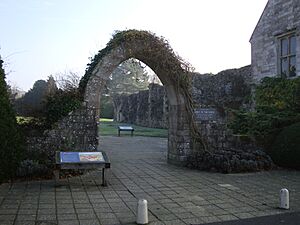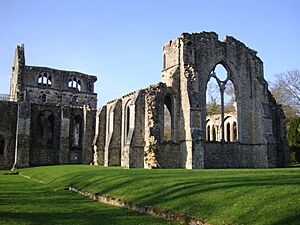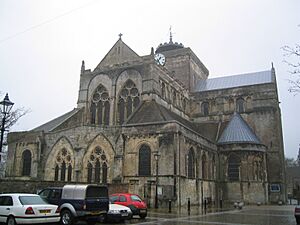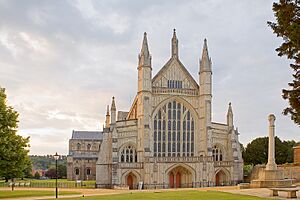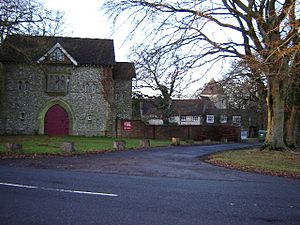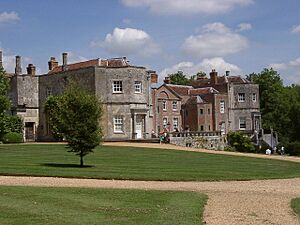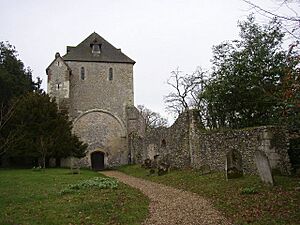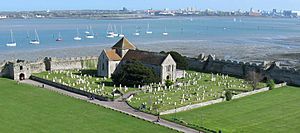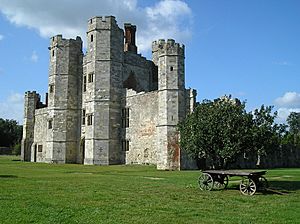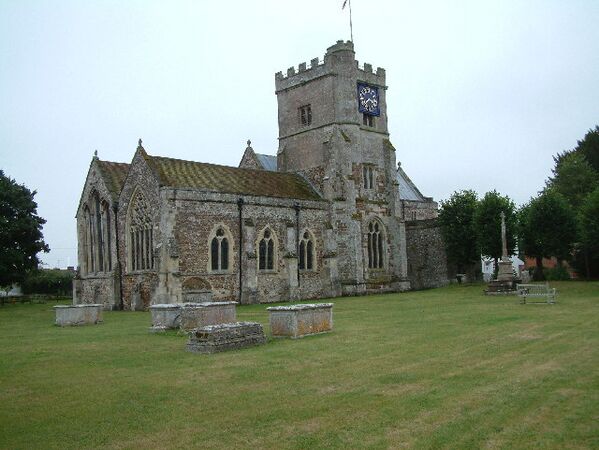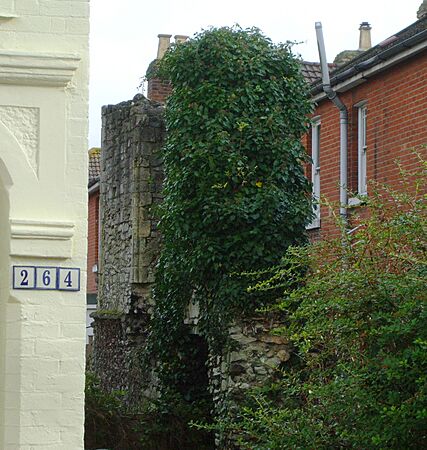Abbeys and priories in Hampshire facts for kids
Abbeys and priories in Hampshire lists the old monasteries, priories, and friaries in Hampshire, England. These were special religious houses where monks, nuns, or friars lived and prayed.
What were Monasteries?
Monasteries were places where groups of people, called monks or nuns, lived together under religious rules. They dedicated their lives to prayer, study, and work.
- An abbey was a large monastery led by an abbot (for monks) or an abbess (for nuns).
- A priory was usually smaller than an abbey and was led by a prior or prioress. Sometimes, a priory was like a branch of a larger abbey.
- A friary was a home for friars, who were different from monks because they often traveled and preached to people, instead of staying mostly within their monastery walls.
Hampshire, especially the city of Winchester, was very important for these religious houses. Many powerful monasteries were built there. For example, the Benedictine monks had big houses like the Priory of St Swithun and Newminster, which were even started by kings!
Hampshire also had many "alien priories." These were smaller monasteries that belonged to larger ones in other countries, often in Normandy (part of France today). This was probably because Hampshire was easy to reach from the continent.
The Cistercian monks, who liked quiet and remote places, built Beaulieu and Netley in the New Forest. These were very peaceful spots.
Winchester was special because it was one of the few cities where all four main groups of mendicant friars (traveling preachers) had their own houses. There were also six houses for Austin Canons, another type of religious community. However, there were no Carthusian or Gilbertine monasteries in Hampshire.
The Knights Templar owned land in Hampshire but didn't have any main houses. The Knights Hospitaller, another military-religious group, had only one special house called a preceptory at North Baddesley.
Besides monasteries, there were also hospitals in places like Winchester, Southampton, and Portsmouth. These weren't like modern hospitals, but places that helped poor travelers, the sick, and those who needed care. There were also colleges at Marwell, Winchester, and Basingstoke, which were often religious schools.
Where were they located?
This map shows where the abbeys and priories were located in Hampshire before they were closed down.
Map key
This key helps you understand the symbols on the map:
| Towns that had more than one type of religious order. | |
| Places where Benedictine monks or nuns lived. | |
| Houses of Augustinian Canons. | |
| Homes of Cistercian monks. | |
| Places belonging to the Tironensian order. | |
| Houses of Premonstratensian Canons. | |
| Locations of the Knights Hospitaller. | |
| Other types of religious houses. |
Winchester's Monasteries
Winchester had many different religious houses:
 Austin Friary
Austin Friary Dominican Friary
Dominican Friary Carmelite Friary
Carmelite Friary Franciscan Friary
Franciscan Friary Winchester Cathedral Priory
Winchester Cathedral Priory Hyde Abbey
Hyde Abbey St Mary's Abbey
St Mary's Abbey
Southampton's Monasteries
Southampton also had its share of religious houses:
List of Abbeys, Priories, and Friaries
The table below lists the different religious houses in Hampshire. They are listed in alphabetical order to make them easy to find.
Monastic houses are special places where groups of people, often called monks or nuns, lived together. They dedicated their lives to religious practices, prayer, and work. These communities followed strict rules and often lived separately from the rest of society.
In Hampshire, a county in England, there were many such places. Some were large abbeys, while others were smaller priories or friaries. These buildings were important centers for learning, farming, and helping the local community. Many of them were built hundreds of years ago, during the Middle Ages.
What Were Monastic Houses?
Monastic houses were buildings where religious people lived together. They followed specific rules for their daily lives. These groups included:
- Monks: Men who lived in monasteries or abbeys. They often belonged to orders like the Benedictines or Cistercians.
- Nuns: Women who lived in convents or nunneries. They also followed strict religious rules.
- Canons: Priests who lived in communities, often serving a cathedral or large church. They were called Canons Regular if they followed a specific rule like St. Augustine's.
- Friars: Unlike monks, friars often lived in towns and cities. They would travel and preach to people. Examples include Franciscans (Greyfriars), Dominicans (Blackfriars), and Carmelites (Whitefriars).
- Knights Hospitaller and Knights Templar: These were military religious orders. They protected pilgrims and cared for the sick. Their homes were called preceptories.
Many of these houses were founded by kings, queens, or wealthy nobles. They were given land and money to support their communities.
Important Monastic Houses in Hampshire
Beaulieu Abbey
Beaulieu Abbey was a large and important Cistercian monastery. It was founded in 1203 by King John. The monks here followed a very strict way of life. They focused on prayer, manual labor, and living simply.
The abbey was dissolved in 1538. This means it was closed down by the king. Today, the ruins of Beaulieu Abbey are part of the Beaulieu Palace House estate. You can still visit and see the impressive remains of this once-great building.
Netley Abbey
Netley Abbey was another Cistercian monastery, founded in 1239. It was a "daughter house" of Beaulieu, meaning it was started by monks from Beaulieu. King Henry III helped to found it.
Like many monasteries, Netley Abbey was dissolved in 1536. After it closed, parts of the abbey were turned into a grand house. Over time, it fell into ruin, but its remains are still very beautiful. They are managed by English Heritage and are a popular place to visit.
Romsey Abbey
Romsey Abbey was a significant Benedictine nunnery. It was likely founded around 907 by Edward the Elder, an early English king. Nuns lived here, dedicating their lives to God.
When the monasteries were dissolved in 1539, Romsey Abbey was also closed. However, the local people bought the church building. This saved it from being destroyed. Today, the abbey church is still used as a parish church. It is a wonderful example of medieval architecture.
Winchester's Monastic Houses
The city of Winchester was a very important religious center. It had many monastic houses, including:
- Winchester Cathedral Priory: This was a large Benedictine monastery connected to Winchester Cathedral. It was founded in 964 and was a major center of power and learning. The cathedral itself is still a working church today.
- Hyde Abbey: Originally called the New Minster, this Benedictine monastery was founded in 901. It moved to Hyde in 1110. It was dissolved in 1539.
- St. Mary's Abbey, Winchester: Also known as Nunnaminster, this was a Benedictine nunnery. It was founded around 902 by Alfred the Great and his wife. It was dissolved in 1539.
- Friaries: Winchester also had several friaries, including Blackfriars, Greyfriars, and Whitefriars. These were homes for different orders of friars who preached and lived among the people in the city.
Other Notable Houses
Alton Abbey
Unlike most entries on this list, Alton Abbey is a modern monastic house. It was founded in 1895 by Anglican Benedictine monks. It is still an active community today, showing that monastic life continues in Hampshire.
Mottisfont Abbey
Mottisfont Abbey was an Augustinian priory founded in 1201. After it was dissolved in 1536, the buildings were turned into a grand mansion. Today, it is a beautiful country house managed by the National Trust.
Pamber Priory
Pamber Priory was a small Benedictine priory founded around 1100. It was an "alien house," meaning it was dependent on a monastery in France. The priory church is still standing and is used as a local parish church.
Portchester Priory
Portchester Priory was an Augustinian priory founded in 1128 within the walls of Portchester Castle. The site was not ideal, so the community moved to Southwick around 1145. The original priory church at Portchester is still used as a parish church today.
Titchfield Abbey
Titchfield Abbey was a Premonstratensian monastery founded in 1232. It was dissolved in 1537. Like Mottisfont, parts of the abbey were converted into a mansion called 'Palace House'. The ruins are now managed by English Heritage.
The Dissolution of the Monasteries
Most of the monastic houses in Hampshire, and across England, were closed down in the 1530s. This event is known as the Dissolution of the Monasteries. It happened during the reign of King Henry VIII. The king wanted more control over the Church and its wealth.
After the dissolution, the lands and buildings of the monasteries were taken by the Crown. Many were sold off to wealthy families. Some buildings were completely destroyed, while others were turned into private homes or used for other purposes. This changed the landscape of England forever.
Images
Hospitals
As mentioned, "hospitals" in the past were places that offered shelter and care, especially for the poor, sick, or travelers. Here are some of the notable hospitals in Hampshire:
- Hospital of St Cross, near Winchester
- Hospital of St Mary Magdalen, Winchester
- Hospital of St John the Baptist, Winchester
- Hospital of St Julian, or God's House, Southampton
- Hospital of St Mary Magdalen, Southampton
- Hospital of God's House, Portsmouth
- Hospital of St John the Baptist, Basingstoke
- Fordingbridge Hospital
Colleges and Collegiate Churches
Colleges in this context were often religious communities that focused on education or prayer, sometimes connected to a church.
- Marwell College
- College of St Elizabeth, Winchester
- Chapel and Gild of the Holy Ghost, Basingstoke
See Also


